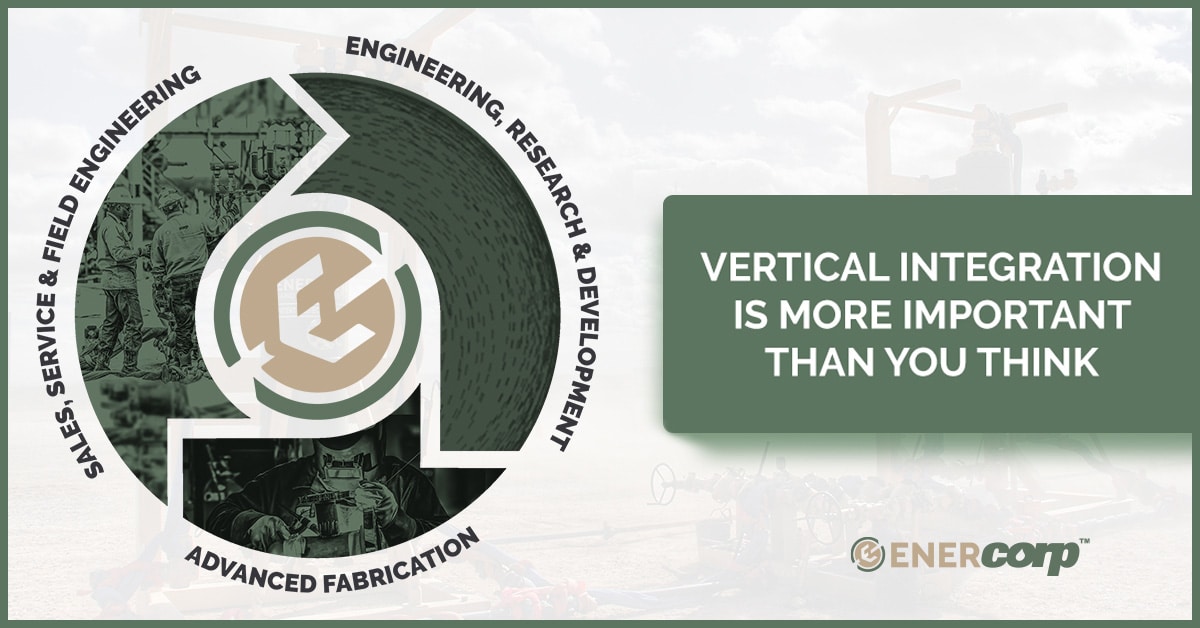
Vertical integration in your flowback and sand management service provider is more important than you think
Estimated reading time: 5 minutes
Table of contents
Think about it: does it really matter to you what the organizational structure of a company you hire looks like?
While you may be thinking you don’t really mind how a company is set up as long as they get the job done, there is something else you might want to consider. What if how a company is organized actually affects the quality of work they do and the results they provide their customers?
In the oil and gas industry, vertical integration isn’t as common as you may think — which is why it is a major competitive advantage for EnerCorp and our customers. Our ability to not only develop, design, and construct fit-for-purpose flowback and sand management technology for our customers but also operate it at the wellsite gives us a unique perspective that not many companies in our industry have. With this organizational structure, EnerCorp has the ability to continuously improve our offerings because we see them first hand in the field — and this means our customers get better technology, processes, and service with us than anywhere else.
Vertical integration at EnerCorp
Think of vertical integration at EnerCorp as a continuous loop. We design, build, sell, engineer, and operate our technology in the field, which creates a holistic end-to-end capability not offered by our competitors. Why should this matter to customers? Through this process, we can optimize the application of our products in a cost-effective manner while continuously improving our capabilities.
Here’s what our organization looks like from a 10,000-foot perspective:

Engineering, research, and development:
You can think of this area of our business as the brains of the operation, where ideas are developed, tested, and then tested again a hundred times over. Our teams spend years in research and development before a solution is made available to customers because we want to be 100% sure that what we are offering works exactly how we need it to.
Advanced fabrication:
This area of the business is the hands, where we make ideas come to life. Once they are thoroughly tested by the engineering, research, and development teams, the ideas go to our 35,000 ft2 fabrication facility in Grande Prairie, Alberta, Canada where they take physical form. Our in-house engineering, quality control, and project management teams ensure every part and every piece of equipment is built to exact standards and meets all safety specifications.
Sales, service, and field application engineering:
This area of the business combines both the brains and the hands and brings them together. Our teams operate our flowback and sand management technology in the field, always looking at the performance and considering how it can be improved. They bring those ideas and observations back to the engineering, research, and development team, who then further enhance those ideas through testing and research. Then, our advanced fabrication team makes those improvements a reality.
This cycle of innovation and enhanced performance goes round and round each day at EnerCorp. It’s not a linear progression that stops at the end, but a continuous feedback loop that keeps going because we know there is always room for improvement.
How vertical integration factors into the EnerCorp process
Application engineering plays a major role in how EnerCorp helps customers achieve their goals. Our ability to create custom fit-for-purpose solutions and always offer clarity on the job are related to our continuous improvement approach.
Understand and analyze expected well conditions:
In this first part of the process, our sales and application engineering teams meet with the customer to understand their oil rate, water rate, gas rate, well pressures, and sand loading requirements. The engineers review and analyze the data, conduct CFD modeling, and make empirical comparisons.
The piping and instrumentation diagram phase is an important part of the first step of our process. Take a look at the many experienced teams that take part in this process to ensure optimal results.
- Scoping: Our operations, sales and engineering teams meet with customers to capture requirement details and our engineering team selects the appropriate nozzles for the job.
- Drafting: The engineering team begins drafting the P&ID which is reviewed and revised several times to ensure safe technical requirements and accuracy.
- Ops checking: Every single component, note, symbol, well name, and other details are rigorously checked by the operations team as well as the engineering team.
- Informing customers: Once the P&ID is internally reviewed by all parties, it is sent to the customer for their final approval.
- Rigging up: The operations team completes the rig up and does the line walk with the customer. If any deviation from the P&ID is required, the engineering team is looped back into the process to ensure safety and accuracy.

Construct a fit-for-purpose solution for the well:
We optimize layouts so that we use only what is necessary and nothing more at the wellsite. This leads to lower overall costs as a result of minimized equipment. There is also less personnel at the wellsite required to operate the equipment, reducing environmental and safety hazards.
Deliver flawless execution:
Our highly trained EnerCorp operators are experienced in optimizing performance at the wellside. We take hourly measurements and reports and monitor for variance to spot any anomalies and trends. This allows our teams to catch any issues before they happen and have a solution ready for any problem that arises.
It’s time to think bigger
While customers don’t often think of vertical integration, it can make a big difference to the results they achieve with their service provider. Ready to learn how our vertically integrated organization can support all your flowback and sand management needs? Get in touch.
Share this Article
